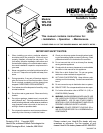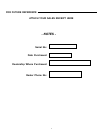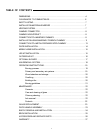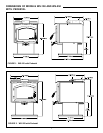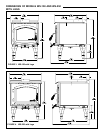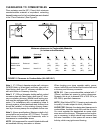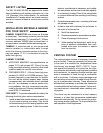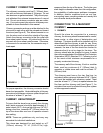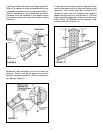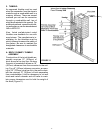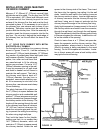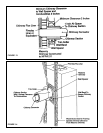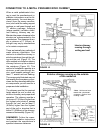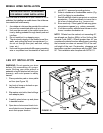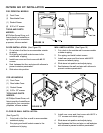
8
CHIMNEY CONNECTOR
The chimney connector must be 6" (152mm) diam-
eter with a minimum thickness of 24 gauge. Do not
use aluminum or galvanized steel. They cannot prop-
erly withstand the extreme temperatures of a wood
fire. Do not use chimney connector pipe as a chim-
ney. You must connect your stove to a chimney com-
parable to those illustrated in this manual.
Chimney connector sections must be attached to the
stove and to each other with the crimped end toward
the stove (see Figure 6). This allows creosote to run
into the stove and not onto the outside of the pipe.
Attach the chimney connector to the flue collar with
three sheet metal screws. All joints should also be
secured with three sheet metal screws. Otherwise,
in the event of a creosote fire, the connector may vi-
brate apart.
For proper operation, the chimney connector should
be as short as possible. Horizontal lengths of chimney
connector should have a minimum upward slope from
the stove of at least ¼" per foot.
CHIMNEY HEIGHT/DRAFT
To insure that the stove burns properly, the chimney
draft (static pressure) should be approximately 0.1"
water column (W.C.) during a high burn and .04" W.C.
during a low burn, measured 6" (152mm) above the
top of the stove after one hour of operation at each
burn setting.
NOTE: These are guidelines only, and may vary
somewhat for individual installations.
This stove was designed for and tested on a 6"
(152mm) chimney, 12'-14' (3.66-4.27m) high,
FIGURE 6
measured from the top of the stove. The further your
stack height or diameter varies from this configuration,
the probability of performance problems increases.
In addition, exterior conditions such as roof line,
surrounding trees, prevailing winds and nearby hills
can influence stove performance.
CONNECTION TO A MASONRY
CHIMNEY
1. CHIMNEY:
Should the stove be connected to a masonry
chimney, the chimney should be examined for cracks,
loose mortar, or other signs of deterioration and
blockage. The stove should not be installed until it is
determined that the chimney is safe for use. Since
an oversized flue contributes to the accumulation of
creosote, the size of the flue should be checked to
determine that it is not too large for the stove. The
chimney should also be checked to insure it meets
the minimum standards of the National Fire Protection
Association (NFPA) Standard 211. Following is a list
of the more critical minimum requirements for a
properly constructed chimney.
The masonry wall of the chimney, if brick or modular
block, must be a minimum of 4" (102mm) thick. A
mountain or rubble stone wall must be at least 12"
(305mm) thick.
The chimney must have a fire clay flue liner (or
equivalent) with a minimum thickness of 5/8" (16mm)
and must be installed with refractory mortar. There
must be at least ½ " (13mm) air space between the
flue liner and the chimney wall (see Figure 7). An
equivalent liner must be a listed chimney liner system
or other approved material.
FIGURE 7



